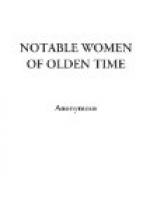He threw open his palaces and pleasure-grounds, his parks and gardens—always of vast extent around eastern palaces—and admitted all the citizens to a feast prepared for them. Tents had been erected within the precincts of the palace for the tables—and these tents were furnished with all the luxurious appendages of the east—with white and green and blue hangings, fastened with cords of fine linen and purple to silver rings and marble pillars; while the beds—the couches around the tables, against which the ancients reclined—were of gold and silver, upon a pavement of red and blue, and black and white marble; while they gave them to drink in vessels of gold. Until these last days the princes and nobles alone had participated in the festive scenes; but now, as we have said, all ranks were allowed to share, and the citizens of Shushan, subjects of Ahasuerus, thronged the palace and trod the royal gardens, and, entering the tents, enjoyed all that royalty could offer in ancient Persia—far surpassing in costly splendour and elegance the entertainments of modern courts. And surely the monarch must have had strong confidence in the security of his government and the loyalty of his people, as he thus from day to day, for successive days, flung open to them the recesses of his palace.
While the king thus feasted the men in the gardens and parks of the palace, Vashti, the queen, held a festival for the women within the secluded apartments appropriated to the female part of the royal household. She made them a feast within the house of Ahasuerus; and this queenly entertainment was conducted with all that regard for retirement and decorum which accords with Eastern manners. But whatever the amusements of the queen and her train of attendants, no rumours passed the carefully guarded bounds of the women’s apartments. At length the long season of pleasure came to a harmonious close. No outbreak of the people of Shushan, no rising of distant provinces, no plotting of high-born traitors had marred the festal pomp. Yet the season of pleasure is always a period of trial, and the seeds of remorse and repentance are almost invariably sown in the hours of gayety. Amid all this brightness, a dark cloud hung over Ahasuerus. On the seventh and last day, when the heart of the king was merry—when he had forgotten royalty dignity and personal decorum, by sitting too long at the festive board—excited by pride and vanity, and stimulated by wine, he resolved to dazzle the eyes of the people by presenting to their admiration a gem, brighter and more lovely than any which sparkled in the royal crown. To verify his loud boasts of her matchless charms, he sent his chamberlain to bid the queen array herself in that royal attire which befitted her state while it displayed her beauty and proclaimed her rank, and thus present herself, that the assembled multitudes might admire her loveliness and confess his happiness.
In Western lands, and in modern days, this command would convey no idea of shame or impropriety. The royal consort and her train of fair attendants have often graced the presence and shared the honours of the monarch and his court, and added refinement to luxury. But no offer could be more opposed to all ideas of Eastern delicacy and propriety—more degrading to the woman, or more offensive to the queen.




